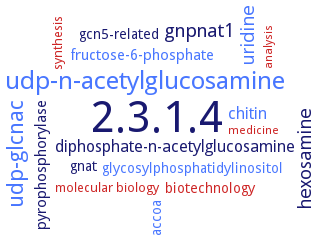Please wait a moment until all data is loaded. This message will disappear when all data is loaded.
Please wait a moment until the data is sorted. This message will disappear when the data is sorted.
G68S
-
the mutant called lignescens, a temperature-sensitive mutant that exhibits ectopic lignin deposition and growth defects under high-temperature conditions, is due to single base transition G68S in glucosamine-6-phosphate N-acetyltransferase. When exposed to the restrictive temperature, the mutant strain contains a significantly smaller amount of UDP-GlcNAc than the wild type. The growth defects and ectopic lignification of the mutant are suppressed by the addition of UDP-GlcNAc. N-glycans are reduced and luminal binding protein 3, a typical UPR gene, is expressed in the mutant strain at the restrictive temperature. Treatment with UPR-inducing reagents phenocopies the mutant
E185Y
-
Km (mM): 0.03 (D-glucosamine 6-phosphate), 0.04 (acetyl-CoA), kcat (1/sec): 1.34 (D-glucosamine 6-phosphate)
G183E
-
Km (mM): 0.056 (D-glucosamine 6-phosphate), 0.1 (acetyl-CoA), kcat (1/sec): 0.34 (D-glucosamine 6-phosphate)
V125R
-
Km (mM): 0.6 (D-glucosamine 6-phosphate), 0.2 (acetyl-CoA), kcat (1/sec): 0.12 (D-glucosamine 6-phosphate)
Y174F
-
crystal structure of the mutant Y174F acetyl-CoA/glucose-6-P complex is indistinguishable from the wild-type complex, mutant displays some remaining activity, kcat: 0.076/sec (glucosamine 6-phosphate)
Y189R
-
Km (mM): 0.056 (D-glucosamine 6-phosphate), 0.086 (acetyl-CoA), kcat (1/sec): 1.7 (D-glucosamine 6-phosphate)
Q155V/C158G
activity increases by 11.5% at pH 6.5-7.5, with the catalytic efficiency increasing by 27.5% to 1.25 per s and microM
C157A
mutant shows activities of both acetyl- and butyryltransfer, in the range of the wild type enzyme activity
E156A
Km: 1.2 mM (substrate: glucosamine 6-phosphate), kcat = 9.7/sec (substrate: glucosamine 6-phosphate)
E156D
Km: 0.175 mM (substrate: glucosamine 6-phosphate), kcat = 19.3/sec (substrate: glucosamine 6-phosphate)
L138A
mutant shows activities of both acetyl- and butyryltransfer, in the range of the wild type enzyme activity. Ratio of butanoyl-to-acetyltransferase activity is increased to 1
L155A
mutant shows activities of both acetyl- and butyryltransfer, in the range of the wild type enzyme activity
L155A/N161A
mutant shows activities of both acetyl- and butyryltransfer, in the range of the wild type enzyme activity
L155G
mutant shows activities of both acetyl- and butyryltransfer, in the range of the wild type enzyme activity. Ratio of butanoyl-to-acetyltransferase activity is increased to 0.9
L155G/N161A
mutant shows activities of both acetyl- and butyryltransfer, in the range of the wild type enzyme activity. Ratio of butanoyl-to-acetyltransferase activity is increased to 0.85
L158A
mutant shows activities of both acetyl- and butyryltransfer, in the range of the wild type enzyme activity
L158A/N161A
mutant shows activities of both acetyl- and butyryltransfer, in the range of the wild type enzyme activity
L158G
mutant shows activities of both acetyl- and butyryltransfer, in the range of the wild type enzyme activity
L158G/N161A
mutant shows activities of both acetyl- and butyryltransfer, in the range of the wild type enzyme activity
N161A
mutant shows activities of both acetyl- and butyryltransfer, in the range of the wild type enzyme activity
P159A
mutant shows activities of both acetyl- and butyryltransfer, in the range of the wild type enzyme activity
Y165A
mutant shows activities of both acetyl- and butyryltransfer, in the range of the wild type enzyme activity. Ratio of butanoyl-to-acetyltransferase activity is increased to 0.9
Y165T
mutant shows activities of both acetyl- and butyryltransfer, in the range of the wild type enzyme activity. Ratio of butanoyl-to-acetyltransferase activity is increased to 0.9
biotechnology
-
engineering of a metabolic pathway for high level production of N-acetylglucosamine in Escherichia coli by overexpressing Escherichia coli glucosamine synthase (GlmS) and Saccharomyces cerevisiae glucosamine-6-phosphate acetyltransferase (GNA1)
additional information

-
mutation of the four nonconserved residues (V125, G183, E185 and Y189) lining the sugar-binding pocket suggests that they contribute to the kinetic differences between GNA1 from Aspergillus fumigatus and GNA1 from Homo sapiens
additional information
-
generation of a GlmU knockout strain discloses that GlmU is required for growth of Mycobacterium smegmatis as the bacteria does not grow in the absence of active GlmU enzyme
additional information
-
in a temperature shift experiment (from 30°C to 42°C) the amount of functional GlmU enzyme is gradually reduced the Mycobacterium smegmatis cells become non-viable and their morphology change from a normal rod shape to stubby-rounded morphology and in some cases they lyse




 results (
results ( results (
results ( top
top






